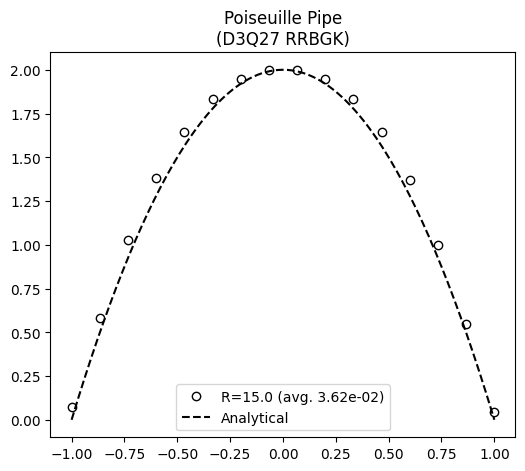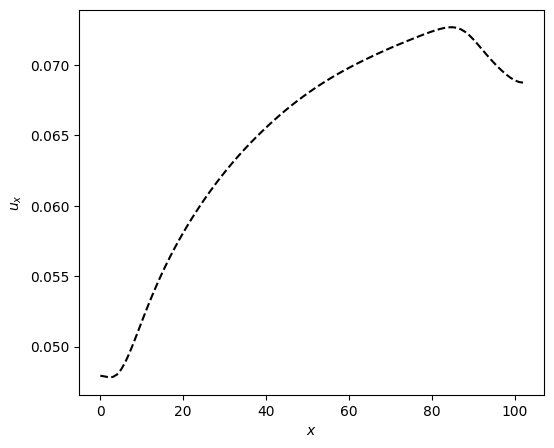Poiseuille Pipe (velocity-Neumann)#
As for the case of a Poiseuille channel flow, this simulation is used as test for the outlet boundary condition with a fixed pressure. A velocity Bounce-Back BC is used at inlet, to provide an increase of pressure at inlet. The fixed pressure at outlet is meant to avoid a constant increase of the domain average density.
from nassu.cfg.model import ConfigScheme
filename = "tests/validation/cases/03_poiseuille_pipe_flow.nassu.yaml"
sim_cfgs = ConfigScheme.sim_cfgs_from_file_dct(filename)
The simulation parameters are shown below
from nassu.cfg.schemes.simul import SimulationConfigs
import pandas as pd
dct = {"N": [], "tau": [], "time_steps": []}
def add_to_dict(sim_cfg: SimulationConfigs):
dct["N"].append(sim_cfg.domain.domain_size.y)
dct["tau"].append(sim_cfg.models.LBM.tau)
dct["time_steps"].append(sim_cfg.n_steps)
sim_cfg = next(
sim_cfg
for (name, _), sim_cfg in sim_cfgs.items()
if name.startswith("velocityNeumannPoiseuillePipeMultilevel")
)
add_to_dict(sim_cfg)
df = pd.DataFrame(dct, index=None)
df
| N | tau | time_steps | |
|---|---|---|---|
| 0 | 32 | 0.51 | 32000 |
In this case, the IBM domain limits for the \(x\)-direction must be set such that the the body is sufficiently far from domain’s boundaries. Otherwise, numerical instability may be found.
Functions to use for processing of poiseuille pipe.
from typing import Callable
import numpy as np
from lnas import LnasFormat
from tests.validation.notebooks import common
def get_poiseuille_pipe_analytical_func() -> Callable:
"""Poiseuille analytical velocity function
Returns:
Callable[[float], float]: Analytical velocity function
"""
return lambda r: 2 * (1 - r * r)
def get_poiseuille_pipe_numerical_avg_vel(ux_vals: np.ndarray) -> float:
# Average velocity is ~half the maximun velocity.
# Numerical integration gives worse results for average velocity
return np.max(ux_vals) / 2
def get_pos_values_inside_pipe(sim_cfg: SimulationConfigs) -> np.ndarray:
lnas_filename = sim_cfg.output.bodies["cylinder"].lnas_transformed
lnas = LnasFormat.from_file(lnas_filename)
vertices = lnas.geometry.vertices
x_val = sim_cfg.domain.domain_size.x * 3 // 4 + 2
z_val = sim_cfg.domain.domain_size.z / 2
min_y, max_y = (vertices[:, 1].min(), vertices[:, 1].max())
min_y, max_y = int(np.floor(min_y)), int(np.ceil(max_y))
p1, p2 = (x_val, min_y, z_val), (x_val, max_y, z_val)
line = np.linspace(p1, p2, num=max_y - min_y, endpoint=False)
return line
def get_pos_values_along_pipe(sim_cfg: SimulationConfigs) -> np.ndarray:
min_x, max_x = 0, sim_cfg.domain.domain_size.x - 1
y_val = sim_cfg.domain.domain_size.y / 2
z_val = sim_cfg.domain.domain_size.z / 2
p1, p2 = (min_x, y_val, z_val), (max_x, y_val, z_val)
line = np.linspace(p1, p2, num=max_x - min_x, endpoint=False)
return line
def plot_analytical_poiseuille_pipe_vels(ax):
x = np.arange(
-1,
1.01,
0.01,
)
analytical_func = get_poiseuille_pipe_analytical_func()
analytical_data = analytical_func(x)
ax.plot(x, analytical_data, "--k", label="Analytical")
Results#
Extract the velocity profile from simulation
import numpy as np
from vtk.util.numpy_support import vtk_to_numpy
extracted_data = {}
array_to_extract = "ux"
export_instantaneous_cfg = sim_cfg.output.instantaneous
macr_export = export_instantaneous_cfg["default"]
time_step = macr_export.time_steps(sim_cfg.n_steps)[-1]
reader = macr_export.read_vtm_export(time_step)
pos = get_pos_values_inside_pipe(sim_cfg)
# Sum 0.5 because data is cell data, so it's in the center of the cell
p1 = pos[0] + 0.5
p2 = pos[-1] + 0.5
line = common.create_line(p1, p2, len(pos) - 1)
# Get the points from the vtkLineSource
polyData = line.GetOutput()
points = polyData.GetPoints()
probe_filter = common.probe_over_line(line, reader.GetOutput())
probed_data = vtk_to_numpy(probe_filter.GetOutput().GetPointData().GetArray(array_to_extract))
extracted_data = {"pos": pos, "data": probed_data}
Extract velocity along the pipe
ux_along_pipe = {}
pos = get_pos_values_along_pipe(sim_cfg)
# Sum 0.5 because data is cell data, so it's in the center of the cell
p1 = pos[0] + 0.5
p2 = pos[-1] + 0.5
line = common.create_line(p1, p2, len(pos) - 1)
# Get the points from the vtkLineSource
polyData = line.GetOutput()
points = polyData.GetPoints()
probe_filter = common.probe_over_line(line, reader.GetOutput())
probed_data = vtk_to_numpy(probe_filter.GetOutput().GetPointData().GetArray(array_to_extract))
ux_along_pipe = {"pos": pos, "data": probed_data}
The velocity profile at the end of simulation is compared with the steady state analytical solution below:
import matplotlib.pyplot as plt
fig, ax = plt.subplots()
fig.set_size_inches(6, 5)
def normalize_pos(pos):
# Normalize between -1 and 1
pos -= pos.min()
pos /= pos.max()
pos -= 0.5
pos *= 2
num_data = extracted_data
num_avg_vel = get_poiseuille_pipe_numerical_avg_vel(extracted_data["data"])
pos_norm = extracted_data["pos"][:, 1].copy()
R = pos_norm.max() - pos_norm.min()
normalize_pos(pos_norm)
ax.plot(
pos_norm,
extracted_data["data"] / num_avg_vel,
"o",
label=f"R={R} (avg. {num_avg_vel:.2e})",
fillstyle="none",
c="k",
)
plot_analytical_poiseuille_pipe_vels(ax)
ax.set_title(f"Poiseuille Pipe\n({sim_cfg.models.LBM.vel_set} {sim_cfg.models.LBM.coll_oper})")
ax.legend()
plt.show(fig)

Good agreement was also obtained for this case, with an coherent flow development.
import pyvista as pv
array_to_inspect = "ux"
time_step = macr_export.time_steps(sim_cfg.n_steps)[-1]
multiblock_file = macr_export.time_step_filename(time_step, ".vtm")
multi_block = pv.read(multiblock_file)
sliced_blocks = multi_block.slice(
normal=[1, 0, 0], origin=[3 * sim_cfg.domain.domain_size.x // 4, 0, 0]
)
plotter = pv.Plotter(window_size=(600, 500))
sliced_blocks.set_active_scalars(array_to_inspect)
plotter.add_mesh(sliced_blocks, cmap="coolwarm")
plotter.show(jupyter_backend="static", cpos="yz", return_cpos=True)

[(165.42562584220408, 16.0, 16.0),
(78.0, 16.0, 16.0),
(0.0, 0.0, 1.0)]
The sectional view of the flow profile shows a axissymmetric flow with a secundary flow ocurring between the IBM body and the boundaries.
import matplotlib.pyplot as plt
fig, ax = plt.subplots()
fig.set_size_inches(6, 5)
ax.plot(
ux_along_pipe["pos"][:, 0],
ux_along_pipe["data"],
"--",
label="Nassu",
fillstyle="none",
c="k",
)
ax.set_ylabel("$u_x$")
ax.set_xlabel("$x$")
plt.show(fig)

The centerline velocity is shown above. It presents asymptotic decay as for the turbulent channel. However, at the end of IBM domain limits, the flow suffers an expansion and the centerline velocity reduces.
Version#
sim_info = sim_cfg.output.read_info()
nassu_commit = sim_info["commit"]
nassu_version = sim_info["version"]
print("Version:", nassu_version)
print("Commit hash:", nassu_commit)
Version: 1.6.33
Commit hash: fbc0edb5260d2734f0a290e1806c26ac6d865ff4
Configuration#
from IPython.display import Code
Code(filename=filename)
simulations:
- name: periodicPoiseuillePipeN16
save_path: ./tests/validation/results/03_poiseuille_pipe_flow/periodic
n_steps: 2000
report:
frequency: 1000
data:
divergence: { frequency: 50 }
instantaneous:
default: { interval: { frequency: 0 }, macrs: [rho, u, f_IBM, S] }
domain:
domain_size:
x: 24
y: 24
z: 24
block_size: 8
bodies:
cylinder:
lnas_path: fixture/lnas/basic/cylinder.lnas
small_triangles: add
transformation:
scale: [8, 8, 8]
translation: [-4, 4, 4]
models:
precision:
default: single
LBM:
tau: 0.8
F:
x: 6.25E-05
y: 0
z: 0
vel_set: D3Q27
coll_oper: RRBGK
engine:
name: CUDA
IBM:
forces_accomodate_time: 1000
body_cfgs:
default: {}
BC:
periodic_dims: [true, false, false]
BC_map:
- pos: N
BC: RegularizedHWBB
wall_normal: N
order: 1
- pos: S
BC: RegularizedHWBB
wall_normal: S
order: 1
- pos: F
BC: RegularizedHWBB
wall_normal: F
order: 2
- pos: B
BC: RegularizedHWBB
wall_normal: B
order: 2
- name: periodicPoiseuillePipeN32
parent: periodicPoiseuillePipeN16
n_steps: 8000
domain:
domain_size:
x: 40
y: 40
z: 40
block_size: 8
bodies: !not-inherit
cylinder:
lnas_path: fixture/lnas/basic/cylinder.lnas
small_triangles: add
transformation:
scale: [16, 16, 16]
translation: [-4, 4, 4]
models:
LBM:
F:
x: 7.8125E-06
y: 0
z: 0
- name: periodicPoiseuillePipeN64
parent: periodicPoiseuillePipeN16
n_steps: 32000
domain:
domain_size:
x: 72
y: 72
z: 72
block_size: 8
bodies: !not-inherit
cylinder:
lnas_path: fixture/lnas/basic/cylinder.lnas
small_triangles: add
transformation:
scale: [32, 32, 32]
translation: [-4, 4, 4]
models:
LBM:
F:
x: 9.76563E-07
y: 0
z: 0
- name: periodicPoiseuillePipeN128
parent: periodicPoiseuillePipeN16
n_steps: 128000
domain:
domain_size:
x: 136
y: 136
z: 136
block_size: 8
bodies: !not-inherit
cylinder:
lnas_path: fixture/lnas/basic/cylinder.lnas
small_triangles: add
transformation:
scale: [64, 64, 64]
translation: [-4, 4, 4]
models:
LBM:
F:
x: 1.22070E-07
y: 0
z: 0
- name: velocityNeumannPoiseuillePipeMultilevel
save_path: ./tests/validation/results/03_poiseuille_pipe_flow/velocity_neumann_multilevel
n_steps: 32000
report:
frequency: 1000
data:
divergence: { frequency: 1 }
instantaneous:
default: { interval: { frequency: 8000 }, macrs: [rho, u, f_IBM, S] }
domain:
domain_size:
x: 104
y: 32
z: 32
block_size: 8
bodies_domain_limits:
start: [4, 8, 8]
end: [88, 40, 40]
is_abs: true
bodies:
cylinder:
lnas_path: fixture/lnas/basic/cylinder.lnas
small_triangles: add
transformation:
scale: [8, 8, 8]
translation: [4, 8, 8]
refinement:
static:
default:
bodies:
- body_name: cylinder
lvl: 1
normal_offsets: [-2, 0, 2]
models:
precision:
default: single
LBM:
tau: 0.51
vel_set: D3Q27
coll_oper: RRBGK
engine:
name: CUDA
BC:
periodic_dims: [false, false, false]
BC_map:
- pos: W
BC: UniformFlow
wall_normal: W
rho: 1.0
ux: 0.05
uy: 0
uz: 0
order: 2
- pos: E
BC: RegularizedNeumannOutlet
rho: 1.0
wall_normal: E
order: 2
- pos: N
BC: Neumann
wall_normal: N
order: 1
- pos: S
BC: Neumann
wall_normal: S
order: 1
- pos: F
BC: Neumann
wall_normal: F
order: 0
- pos: B
BC: Neumann
wall_normal: B
order: 0
IBM:
forces_accomodate_time: 1000
body_cfgs:
default: {}
